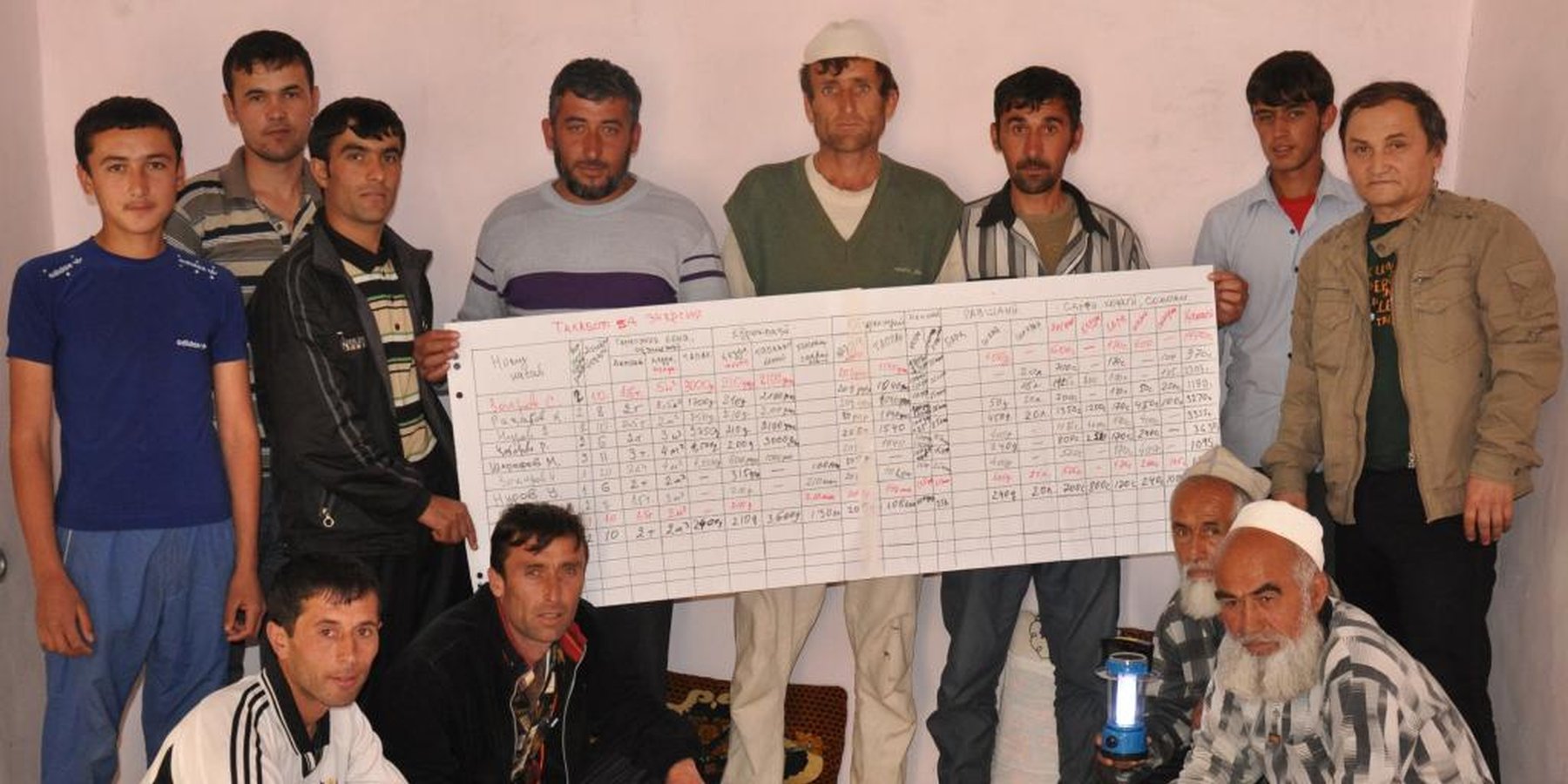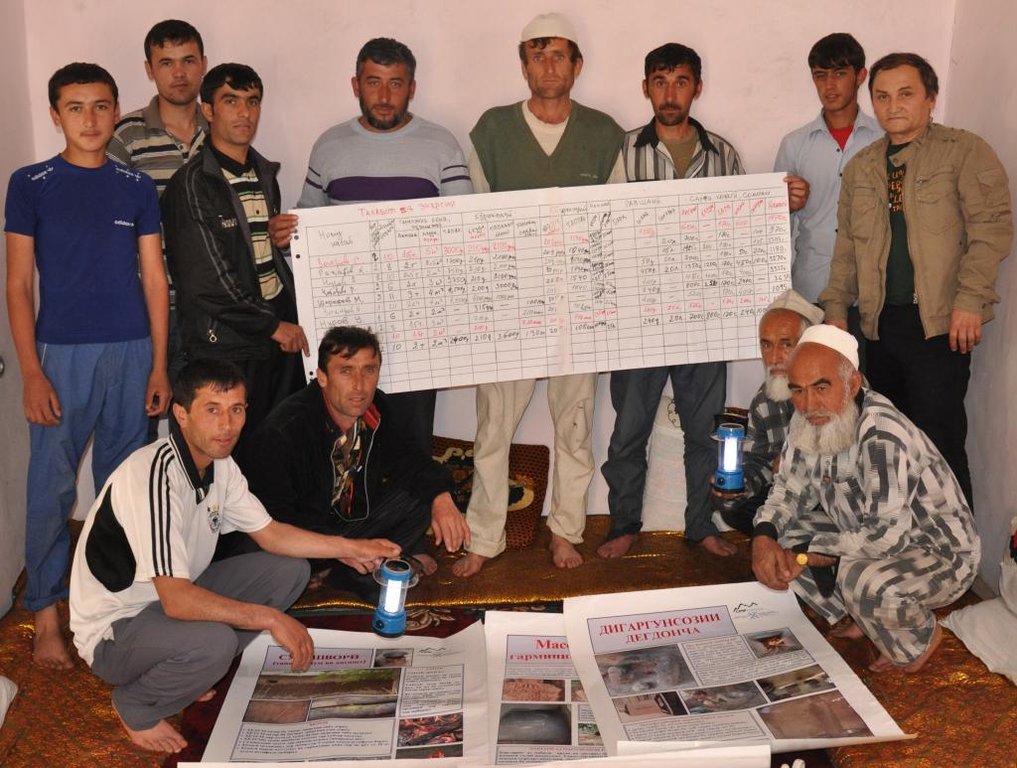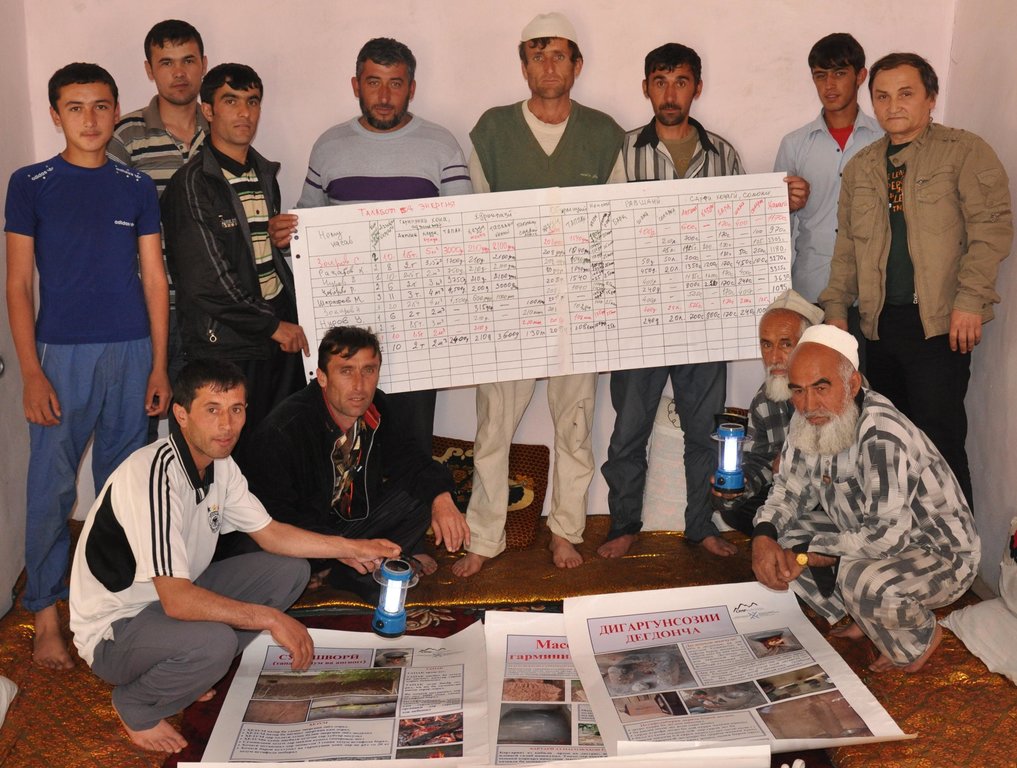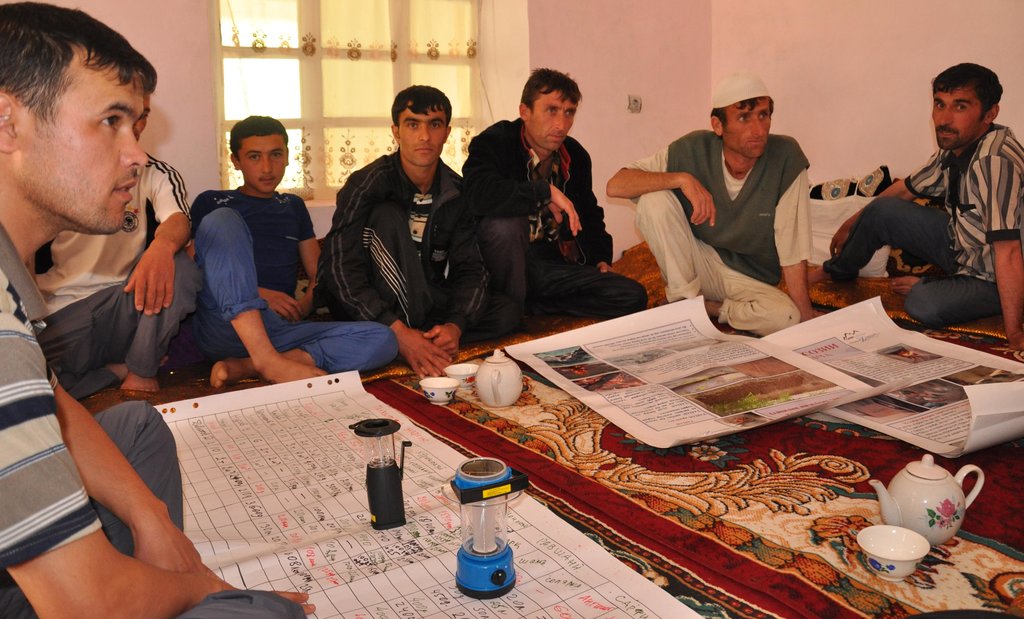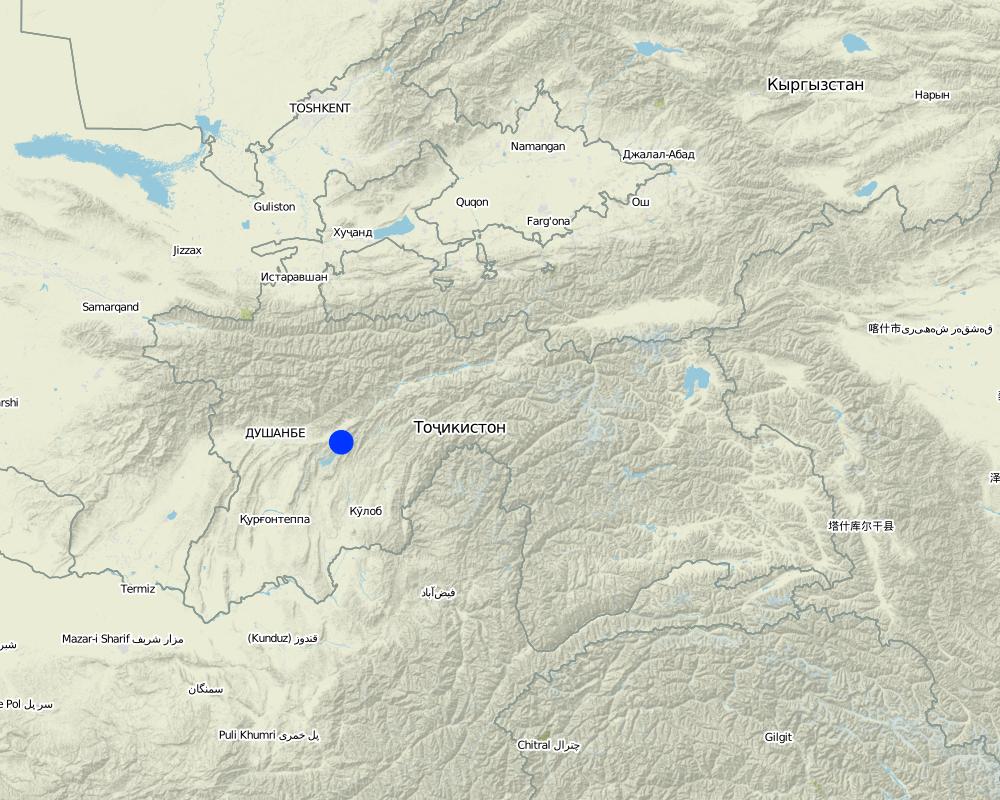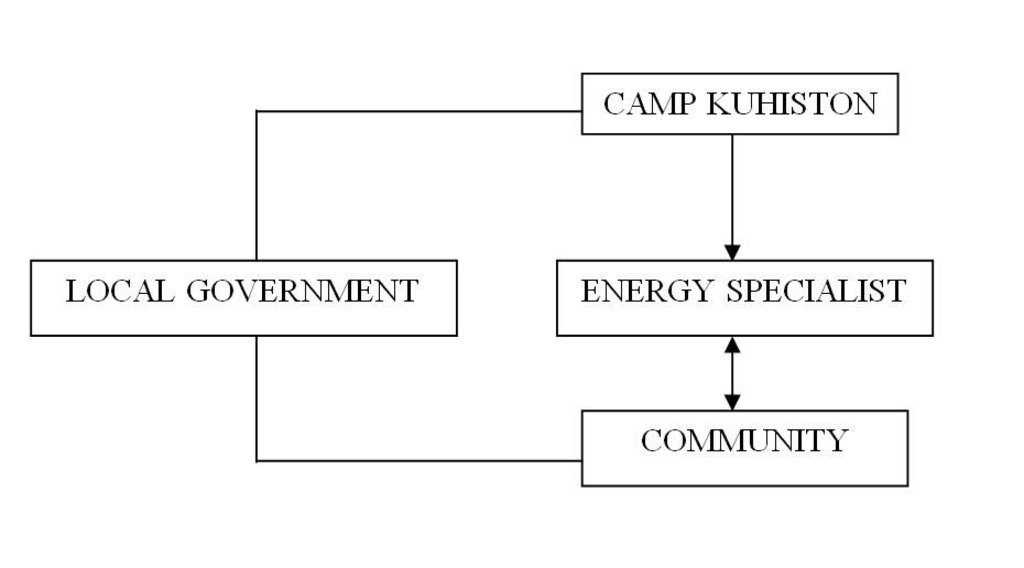Participatory Cost Benefit Analysis for Energy Efficiency Measures [Tajiquistão]
- Criação:
- Atualização:
- Compilador/a: shane stevenson
- Editor: –
- Revisor: David Streiff
approaches_2442 - Tajiquistão
Veja as seções
Expandir tudo Recolher tudo1. Informação geral
1.2 Detalhes do contato das pessoas capacitadas e instituições envolvidas na avaliação e documentação da abordagem
Especialista em GST:
Pochoev Mirzo
992 44 601 55 05
CAMP Kuhiston
Dushanbe
Tajiquistão
Nome da(s) instituição(ões) que facilitou(ram) a documentação/avaliação da Abordagem (se relevante)
CAMP - Central Asian Mountain Partnership (CAMP - Central Asian Mountain Partnership) - Quirguizistão1.3 Condições em relação ao uso da informação documentada através de WOCAT
Quando os dados foram compilados (no campo)?
25/04/2011
O/a compilador/a e a(s) pessoa(s) capacitada(s) aceitam as condições relativas ao uso de dados documentados através da WOCAT:
Sim
1.4 Referência ao(s) questionário(s) sobre tecnologias da GST
2. Descrição da abordagem de GST
2.1 Descrição curta da abordagem
The use of a cost benefit analysis approach to assess the financial and natural resource needs for energy consumption at community level, and further attribute costs to SLM practices to meet this need, and subsequently improve rural livelihoods.
2.2 Descrição detalhada da abordagem
Descrição detalhada da abordagem:
Aims / objectives: To collate quantitative data on the amount of energy used within the community in terms of financial expenditure and natural resource use. Through the use of a participatory workshop the attendees determine which natural resources are being utilised, in the form of wood, bush and organic materials. The objective is to use this quantitative data to encourage through cost benefit demonstrations, the implementation of Sustainable Land Management technologies to reduce the amount of natural resources exploited, and the expenditure on energy consumption.
Methods: An energy specialist organises a community based workshop with up to 15 participants. In the 2-3hr workshop the participants complete, under guidance, a pre prepared flip chart on energy use (electric, tapak, wood, coal, brush). The information is collected in financial expenditure and weight. Once the energy assessment is completed a subsequent discussion is encouraged on how to more effectively meet this need at a community level. The moderator also takes this oppoprtunity to demonstrate several technologies including solar lights, improved stove design, thermal insulation, and the development of energy forests. The information is collated and used as a baseline assessment for evaluation of implemented technologies.
Stages of implementation: The stages of implementation are relatively straight forward. First you must select the community that you wish to work in, and inform a community mobiliser, in this case the head of the village that you wish to conduct a 2-3 hr workshop for up to 15 participants, and that the participants must be the person in the households who is responsible (or has knowledge of) the energy use within the household. The moderator prepares a flip chart with a table of fuel types used in the village and uses this as the basis of the workshop to extract information on energy use within the community. Once the information is collated, a discussion is encouraged to review the information and devise means by which this amount can be reduced. The moderator then takes this opportunity to demonstrate several low cost energy efficiency measures that may appeal to the community.
Role of stakeholders: The community are expected to attend the workshop, engage in active discussions on their energy use and ways in which it can be reduced. The workshop needs to be supported by the local government, this provides gravitas, and a platform to launch the approach in other communities. The final stakeholder is the implementer, in this case a local NGO who organises the workshop, demonstrates the technologies and provides ongoing support during the implementation of the technologies.
Other important information: It is important to understand the spending habits of the participants, if they are used to spending on a day to day basis and not used to financial planning, it is important to recognise this fact in the implementation of the technology.
2.3 Fotos da abordagem
2.5 País/região/locais onde a abordagem foi aplicada
País:
Tajiquistão
Região/Estado/Província:
RRS
Especificação adicional de localização:
Nurobod, Shaftuti Bolo
Map
×2.6 Datas de início e término da abordagem
Indique o ano de início:
2011
Ano de término (caso a abordagem não seja mais aplicada):
2012
2.7 Tipo de abordagem
- Baseado em projeto/programa
2.8 Principais metas/objetivos da abordagem
The Approach focused mainly on SLM with other activities (Energy Conservation)
There were two main objectives to this approach, the first was to raise awareness on energy use with respect to types of energy, cost and accessibility, and to use this as a platform for encouraging the implementation of low cost energy efficiency measures in the community. The second was to collate baseline data to allow an assessment of how the implemented technologies impacted on energy (and by association natural resources) use and how the expenditure and amounts were reduced in real terms.
The SLM Approach addressed the following problems: This approach was designed to make the participants evaluate and assess the amount of money, time and effort that goes into meeting their energy needs. It is also a clear and precise way to collate information on the amount of natural resources that are been used to meet this need. These natural resources can be in the form on bushes, wood, dung, cotton sticks etc. These resources are being redirected from other purposes such as construction, but also as natural fertilisers, mulch and compost. This directly impacts on agricultural production, household finance and ultimately livelihoods. The reduction in resource use can reduce the risk of conflicts between villages, and reduce pressure on natural resources allowing them to rejuvenate, and increase soil fertility and quality.
2.9 Condição que propiciam ou inibem a implementação de tecnologia/tecnologias aplicada(s) segundo a abordagem
Normas e valores sociais/culturais/religiosos
- Inibitivo
Rural communities emerging from the soviet system have very low business awareness. Even when there are seemingly obvious savings to be made in finance and natural resources there is a lack of appreciation of the potential savings that could be made.
Treatment through the SLM Approach: Discussion on the issue of savings in time, money and resources helps promote better understanding. The concept of pay back had to be repeatedly explained.
Quadro jurídico (posse de terra, direitos de uso da terra e da água)
- Propício
- Inibitivo
Carga de trabalho, disponibilidade de força de trabalho
- Inibitivo
There are times of year when the village participants are otherwise distracted by sowing seeds, harvesting, Ramadan etc.
Treatment through the SLM Approach: The most effective time would be at the end of the winter period when resources are scarce, money constraints are more apparent and energy use is a household priority issue.
Outro
- Inibitivo
In many of the households the men are working away in Russia. This leaves the women in charge of the household, however, many of the energy costs are organised by the men before they leave or on their return.
Treatment through the SLM Approach: Many of the labour migrant leave in the springtime, therefore it would be more effective to organise the workshops at the end of the winter before they leave.
3. Participação e papel das partes interessadas envolvidas
3.1 Partes interessadas envolvidas na abordagem e seus papéis
- Usuários de terra/comunidades locais
A representative from each household in the community was involved.
Women hold a traditional role in the society and did not participate in the workshops. The men pay all the bills and see their role as that of the provider for the family.
The entire village suffers from mass labour migration, with nearly all households reliant upon remittances from Russia.
- Especialistas em GST/ consultor agrícola
International support and finance was provided for this approach, however, the questionnaire was developed in collaboration between national and international staff to ensure relevance and applicability to the context.
- Organização não governamental
CAMP Kuhiston
Caso várias partes interessadas foram envolvidas, indique a agência líder:
CAMP Kuhiston
3.2 Envolvimento do usuários de terra/comunidades locais nas diferentes fases da abordagem
| Envolvimento do usuários de terra/comunidades locais | Especifique quem estava envolvido e descreva as atividades | |
|---|---|---|
| Iniciação/motivação | Nenhum | |
| Planejamento | Nenhum | |
| Implementação | Automobilização | they were active in the participation in the workshops and the collation of data. |
| Monitoramento/avaliação | Apoio externo | Active in providing follow-up data to evaluate the success of the project. |
| Research | Nenhum |
3.3 Fluxograma (se disponível)
Descrição:
The project employs an energy specialist to conduct a participatory workshop. The process is supported by the local government.
Autor:
S. Stevenson (CAMP Kuhiston, Dushanbe)
3.4 Decisão sobre a seleção de tecnologia/tecnologias de GST
Especifique quem decidiu sobre a seleção de tecnologia/tecnologias a serem implementadas:
- Principalmente usuários da terra, apoiados por especialistas em GST
Explique:
The participants are presented with a range of potential energy efficiency technologies such as stove adaptation, thermal insulation by experts, however, it is the participants decision as to which technologies are the most appropriate for their communtiy, and how they can implemented.
Decisions on the method of implementing the SLM Technology were made by mainly by land users supported by SLM specialists. One technology involved the adaptation of traditional cooking stoves; demonstrations were provided however, the mechanisms for securing the materials and ensuring the entire village implemented the technology were up to the discretion of the participants.
4. Suporte técnico, reforço das capacidades e gestão do conhecimento
4.1 Reforço das capacidades/ formação
Foi oferecida formação aos usuários da terra/outras partes interessadas?
Sim
Especifique quem foi capacitado:
- Usuários de terra
Caso seja relevante, especifique gênero, idade, status, etnia, etc.
The initial training was for all the households in the village, however, only the men attended due to the religious and cultural position of the region.
Tipo de formação:
- Cursos
Assuntos abordados:
The training included raising awareness on stove adaptation, indoor two room stove construction, solar power, and low cost thermal insulation for rooms.
4.2 Serviço de consultoria
Os usuários de terra têm acesso a um serviço de consultoria?
Não
4.3 Fortalecimento da instituição (desenvolvimento organizacional)
As instituições foram fortalecidas ou estabelecidas através da abordagem?
- Sim, moderadamente
Especifique a que nível (níveis) as instituições foram fortalecidas ou estabelecidas:
- Local
Especifique o tipo de apoio:
- Financeiro
Dê mais detalhes:
The Jephcott Foundation financed local NGO CAMP Kuhiston to implement the approach.
4.4 Monitoramento e avaliação
Monitoramento e avaliação são partes da abordagem?
Sim
Comentários:
socio-cultural aspects were regular monitored by project staff through observations; indicators: Observations of participants understanding of economic benefits.
management of Approach aspects were ad hoc monitored by None through observations; indicators: international staff monitor the set up of the workshops and levels of participation.
There were few changes in the Approach as a result of monitoring and evaluation: The timing of the workshops (i.e the time of year) will be changed to the end of the winter when energy use is more of a priority issue, e.g. cold weather, poor electric supply, lack of easily accessible natural resources
There were no changes in the Technology as a result of monitoring and evaluation: None
4.5 Pesquisa
A pesquisa foi parte da abordagem?
Sim
Especifique os tópicos:
- Sociologia
- Economia/Marketing
Dê mais detalhes e indique quem realizou a pesquisa:
CAMP Kuhiston collated data on energy usage and by association natural resource use. In addition to the participatory workshop CAMP conducted a household questionnaire to assess the suitability of different energy efficiency technologies, and the social vulnerability of the inhabitants, to identify the most effective households to implement energy saving activities.
Research was carried out on-farm
5. Financiamento e apoio material externo
5.1 Orçamento anual para o componente de GST da abordagem
Caso o orçamento exato seja desconhecido, indique a faixa:
- < 2.000
Comentários (p. ex. principais fontes de recursos/principais doadores):
Approach costs were met by the following donors: international non-government (Jephcott Foundation, UK): 100.0%
5.2 Apoio financeiro/material concedido aos usuários da terra
Os usuários da terra receberam apoio financeiro/material para a implementação de tecnologia/tecnologias?
Não
5.3 Subsídios para entradas específicas (incluindo mão-de-obra)
- Equipamento
| Especifique quais entradas foram subsidiadas | Em que medida | Especifique os subsídios |
|---|---|---|
| Posters and stationery | Totalmente financiado | |
- Construção
| Especifique quais entradas foram subsidiadas | Em que medida | Especifique os subsídios |
|---|---|---|
| Metal sheets, demonstration material | Totalmente financiado | |
Comentários:
Metal sheets and some other basic materials were provided for the demonstration adaptation of the outdoor cooking stoves.
5.4 Crédito
Foi concedido crédito segundo a abordagem para atividades de GST?
Não
5.5 Outros incentivos ou instrumentos
Foram utilizados outros incentivos ou instrumentos para promover a implementação das tecnologias de GST?
Sim
Caso afirmativo, especifique:
The Jephcott Foundation financed local NGO CAMP Kuhiston to implement the approach.
6. Análise de impactos e declarações finais
6.1 Impactos da abordagem
A abordagem auxiliou os usuários da terra a implementar e manter as tecnologias de GST?
- Não
- Sim, pouco
- Sim, moderadamente
- Sim, significativamente
The extent to which it will reduce the amount and type of natural resource use will be re assessed at the end of the project. It is estimated that there will be a 20% reduction.
A abordagem concedeu autonomia aos grupos social e economicamente desfavorecidos?
- Não
- Sim, pouco
- Sim, moderadamente
- Sim, significativamente
The approach was implemented in a socially disadvantaged area.
Did other land users / projects adopt the Approach?
- Não
- Sim, pouco
- Sim, moderadamente
- Sim, significativamente
Did the Approach lead to improved livelihoods / human well-being?
- Não
- Sim, pouco
- Sim, moderadamente
- Sim, significativamente
The stove adaptation should lead to a 10-20% reduction in natural resources used for cooking, and the solar lights could make a $100/year saving.
Did the Approach help to alleviate poverty?
- Não
- Sim, pouco
- Sim, moderadamente
- Sim, significativamente
It should help reduce spending on energy, dependence on natural resources, and increase the amount of organic materials for agricultural purposes.
6.2 Principal motivação dos usuários da terra para implementar a GST
- Lucro (lucrabilidade) aumentado, melhora da relação custo-benefício
The approach is designed to highlight to households how much of their income they spend on energy.
- Prestígio, pressão social/coesão social
Social pressure ensured all the households participated.
- well-being and livelihoods improvement
Improvement in living conditions and saving of finance and natural resources.
6.3 Atividades de sustentabilidade de abordagem
Os usuários da terra podem manter o que foi implementado através da abordagem (sem apoio externo)?
- Incerto
Caso negativo ou incerto, especifique e comente:
The participants will be encouraged to re-assess their natural resource use in the following year, and hopefully instigate their own measures to tackle the issue.
6.4 Pontos fortes/vantagens da abordagem
| Pontos fortes/vantagens/oportunidades na visão do usuário da terra |
|---|
| Quick and simple way to put an economic cost on fuel use. |
| Pontos fortes/vantagens/oportunidades na visão do/a compilador/a ou de outra pessoa capacitada |
|---|
| The approach needs minimal resources and is relatively easy to implement. (How to sustain/ enhance this strength: It would be easy to replicate and easy to teach others how to undertake the approach.) |
| It makes participants evaluate what they need to run their households, and puts an economic and natural resource value on the process. |
| It helps focus the participants on how much time, effort and money are being used to run their household. (How to sustain/ enhance this strength: To follow up, to see how effective the implementation of the technologies was in reducing their energy needs.) |
| The scope of the level of participation is flexible and can be adapted to the contexts. It allows for direct comparison for before and after the implementation of the technology. (How to sustain/ enhance this strength: It could be further developed to put an economic value on SLM technologies.) |
6.5 Pontos fracos, desvantagens da tecnologia e formas de superá-los
| Pontos fracos/vantagens/riscos na visão do/a compilador/a ou de outra pessoa capacitada | Como eles podem ser superados? |
|---|---|
| It requires participants to have good quality data available to be effective. | Complete follow up visits to households to check data quality. |
7. Referências e links
7.1 Métodos/fontes de informação
- visitas de campo, pesquisas de campo
- entrevistas com usuários de terras
Links e módulos
Expandir tudo Recolher tudoLinks
Não há links
Módulos
Não há módulos


